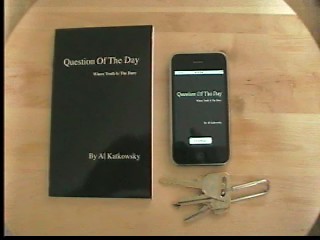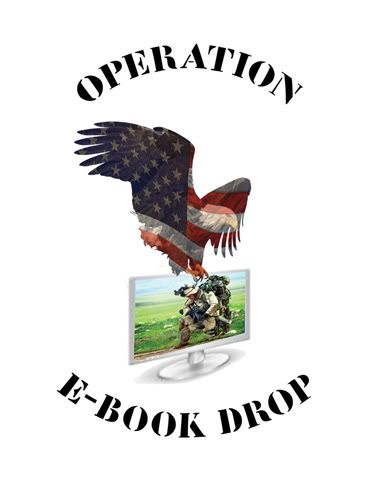Earlier this week I went to see a talk given by author Al Katkowsky at the Apple Store in Santa Monica. If you’re wondering why an author would be speaking at the Apple Store, it’s because Al has published his book, Question of the Day, in both print and iPhone application (a.k.a. “app”) editions, and the app edition has been hugely popular. It seems that in addition to self-publishing in print, ebook and podcast/audiobook formats, indie authors now have yet another publication opportunity at their disposal.
 Question of the Day began life as a simple, workplace pastime. Al would pose a question to co-workers, providing fodder for discussion. Eventually someone suggested Al turn his questions into a book, and he did, classifying them on a scale of “Light” to “Heavy” based on how serious or easygoing each question is. Once the manuscript was finished, he spent about a year querying on it. He received a lot of encouragement but no offers, and started thinking about alternative routes to reaching a readership.
Question of the Day began life as a simple, workplace pastime. Al would pose a question to co-workers, providing fodder for discussion. Eventually someone suggested Al turn his questions into a book, and he did, classifying them on a scale of “Light” to “Heavy” based on how serious or easygoing each question is. Once the manuscript was finished, he spent about a year querying on it. He received a lot of encouragement but no offers, and started thinking about alternative routes to reaching a readership.
Al was a fan of Urban Outfitters, which stocks books in addition to clothing, home furnishings, electronics and miscellany. He approached an UO buyer, who was very enthusiastic about Question of the Day and expressed interest in carrying it. Al knew that the timeframe from contract to release for a traditionally-published book is a year or longer, and he worried that UO’s interest might wane if he couldn’t get the book to them right away. So he self-published 1,000 copies through Cafepress (correction – Al only ordered a few samples through Cafepress) and returned to the UO buyer, who sent the idea of carrying QotD in UO stores up the chain of command. Unfortunately, the answer was ultimately “no”.
Disappointed but far from defeated, Al arranged for distribution through Baker & Taylor, and booked a launch event in a Borders store. Following the launch, Al partnered with a speed dating event, in which the content of his book was used for easy icebreakers between the speed daters. Next, he gave a talk to an 8th grade Social Studies class whose teacher had been using the book for class writing prompts.
Al was a bit at loose ends and unsure what more he could do to build a bigger audience for the book. Then a friend suggested he consider releasing the book as an iPhone app, since the iPhone was hot and only getting hotter, and app sales were growing exponentially.
After making some inquiries among Apple- and tech-savvy friends, Al commissioned a developer to turn QotD into an app. Where you’d page through the book, in the app you can look up questions based on how “light” or “heavy” they are, and also get a little help from ‘prompters’: brief suggestions to get your mind working. When Al added videos of sample responses to the app in May of this year, interest in the app increased dramatically. Since then, the app has had 500,000 hits and 80,000 downloads, and has been in the top 25 of all book apps ever since. Al has continued to promote the book and app via speaking engagements in Apple stores, at conferences, and elsewhere.
Al suggests that authors who intend to release their books as apps think outside the box of a typical ebook, which is just static text on a screen. Adding multimedia capabilities, such as sound and video, will make a book app much more appealing. Any interactive functionality you can add that makes sense in the context of your book is worth considering. For example, the next edition of QotD will add the capability to answer and share questions, and the edition following that one will add social networking functionality, enabling users to “see” when someone else is using the app and, if the other party is interested, discuss the questions and their answers with one another. However, Al warns against relying too heavily on hyperlinks as a means of introducing interactivity to your app, since once you’ve escorted a reader out of your app via an internet link there’s no guarantee he’ll come back.
Al thinks a combination text/audiobook with bookmarking capabilities would be a popular type of book app. Users could read the text onscreen, then turn on a voice to pick up reading where they left off when they need to get in the car, or any other time reading the text onscreen isn’t practical.
Since apps can be updated at any time, and iPhone users love getting updates that add new value or functionality to apps they’ve already purchased or downloaded, Al strongly encourages authors to release a large chunk of their books for free, one chapter at a time. “Hook ‘em in,” he says, “then charge them to finish reading the book.” In an app you can display a message to the user asking him to please pay a fee to continue reading, and the user can do so immediately right on his iPhone or iPod Touch. Alternatively, you can release an updated version of the app that includes the final chapters and can only be downloaded for a fee. If your content is good and you’ve provided enough of it, conversion rates from the free app to the paid app should be high.
Hiring a developer to create your app can be costly, and will definitely require some research and an interview process. There are some new companies popping up to offer simple, affordable app creation services as an alternative; I’m starting to investigate these and plan to report my findings in the future. But you may be wondering why it’s worthwhile to release your book as an app in the first place, given that considerable time, effort and money can be required.
The first reason is that you’ve created a podcast version of your book, and would like to sell it as an audiobook through iTunes. Currently, the iTunes store has an exclusive deal with Audible whereby only audiobooks released by Audible can be sold in the “Audiobooks” department of the iTunes store. Any other audiobook must be released as a podcast, and audiobooks are lost among all the other podcasts offered on iTunes. However, there’s no exclusive deal governing the “Books” department of the app store. Your audiobook app can coexist and be listed right alongside NYT bestsellers.
The second reason is to enlarge your book’s exposure. The books of authors who publish through Smashwords are already available to iPhone/iPod Touch users who use the Stanza reader app, the books of authors who publish through Shortcovers can be read by users who have the Shortcovers app, and the books of authors who publish in Kindle editions can be read by users who have the Kindle reader app. However, those authors’ books aren’t listed right on the iTunes site, or in the app store. Users have to find the books by browsing the virtual shelves inside each respective reader app, and each virtual store has thousands of titles to choose from. Your book won’t be discovered by any users who don’t have the appropriate reader app installed. If you publish your book as an app, however, users don’t need to have any special reader app to find or read your book, your app isn’t hidden inside another app. You still have the same promotion and marketing challenge as any other author, but you’ve removed a barrier to discovery.
The third reason is to make your book into something more than static content. If your book could benefit from embedded video or audio clips, embedded game experiences, or social networking connectivity (like Al’s book), publishing in ebook or audiobook format alone will not realize your book’s full potential. Imagine a novel about a fortuneteller that’s presented with various interactive divination games (e.g., tarot card readings, crystal ball, the I Ching, etc.) embedded in the app. Consider a fantasy adventure novel with an interactive map of the story world included. Imagine a cookbook with step-by-step instructional videos embedded, or a foreign language phrasebook with audio clips that demonstrate proper pronunciation. In books with invented languages or obscure technical terminology, the author can put a pop-up glossary at the user’s fingertips. In a young adult novel where the hero must solve a series of puzzles or riddles to prevail, the author can present the same puzzles and riddles for the user to try his hand right alongside the hero. The possibilities are endless.
One more reason to consider releasing your book as an app is the fact that any author or publisher of content sold by Apple can book speaking engagements in Apple stores all over the world. According to Al, most Apple stores are built with a presentation area somewhere in the store, and store managers have been put on notice that they should be offering speaker events to store clientele at every opportunity. You will be welcome to demonstrate and talk about your app because your talk will essentially serve as an advertisement to buy more stuff from Apple. While Apple will not allow you to put out a press release to publicize your Apple store speaking engagements—they are all about image and brand control—, you can publicize them on your website, via Facebook, Twitter, and any other means you’d ordinarily use to publicize a speaking engagement.
There is one caveat of which authors should be aware before releasing their books as apps: trade publishers don’t tend to view apps as books, even if the app began life as a manuscript. Once it’s an interactive app, it’s possible publishers no longer recognize it as something they can release in print, ebook or audiobook formats. If you have a manuscript or self-published book, ebook or podcast audiobook which you hope to sell to a mainstream publisher, it’s probably unwise to release it as an interactive app in the current publishing climate, but hopefully, that will change in due time. Al has found that despite the great success of his QotD app, he’s not seeing a lot of interest from publishers or literary agents because it no longer looks like a book to them, and they don’t quite know what to do with it. Al is confident that in time, publishers will come to see apps as a publishing opportunity.
For now, if you’re an entrepreneurial-minded indie author who intends to stay indie, apps can be yet another valuable avenue for building readership and selling books.
Learn more about QotD at http://www.questionofthedaybook.com.



 I have to apologize to Publetarians out there who follow my blather — I’m suffering from acute brain overload this week, and will have to postpone my weekly article until next Saturday.
I have to apologize to Publetarians out there who follow my blather — I’m suffering from acute brain overload this week, and will have to postpone my weekly article until next Saturday.